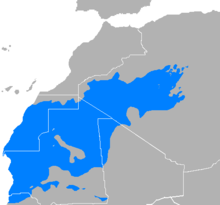Hassania
| Hassania | ||
|---|---|---|
|
Spoken in |
|
|
| speaker | 3.2 million (native speakers) 2.5 million (second language speakers) |
|
| Linguistic classification |
||
| Official status | ||
| Recognized minority / regional language in |
|
|
| Language codes | ||
| ISO 639 -1 |
|
|
| ISO 639 -2 |
|
|
| ISO 639-3 |
|
|
Hassania ( Arabic حسانية, DMG Ḥassānīya ), Hassaniyya , also klām Ḥassān ("language of the Hassan") or klām al-Bīḍān ("language of the whites") is an Arabic dialect .
It is mainly spoken in the western Sahara in Arḍ al-Bīḍān , the area of the Bidhan ( Moors ), which includes the countries of Mauritania and Western Sahara in the center . Hassania is also common in parts of Niger , Mali , Morocco and Algeria . The name klām Ḥassān is derived from the Arab tribes Banī Hassān , who "Arabized" the Berber peoples living there from the 14th century . Klām al-Bīḍān refers either to the social classes of the white Moors or to the entirety of the Arabic-speaking Moors. In addition to Arabic, the dialect also contains African and French foreign words. The nomadic Bedouin origin of the dialect is clear from the large vocabulary on the field of cattle breeding.
The most extensive grammar to date comes from David Cohen, 1963. The work describes the language of the Qibla cultural region in southwest Mauritania, which has been the country's political and cultural center since the French colonial era.
literature
- David Cohen : Le dialecte arabe ḥassānīya de Mauritanie (parler de la Gəbla). Librairie C. Klincksieck, Paris 1963 ( SWB online catalog )
- Catherine Taine-Cheikh: Languages and Identity in Mauritania. In: Ursel Clausen (Ed.): Mauritania - an introduction. German Orient Institute, Hamburg 1994, pp. 131–154, ISBN 3-89173-037-3
